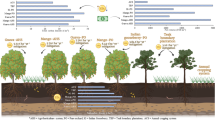Abstract
Forage and wood yield of Acacia cyanophylla, also known as Acacia saligna, was studied in a 300–400 mm precipitation zone in Tunisia. Yields were measured during and after drought. This short (2–8 m) evergreen leguminous tree is used as a forage drought reserve in frost free regions where mean annual precipitation exceeds 250 mm. The standing crop of leafy forage builds up year after year for at least four years or until the tree is cut. It rapidly regrows after cutting from coppice shoots. The leaves provide high protein forage for sheep and goats during the long dry summer season typical of the Mediterranean climate as well as emergency forage during drought. The tree is used to stabilize moving sand dunes, and as a windbreak to protect cropland. It also provides fuelwood and increasaes soil nitrogen by fixation. The need for supplemental irrigation during establishment is a major constraint.
Research in the 350 mm precipitation zone of Tunisia found 3.2 year old trees to yield over 1400 kg of forage standing crop per hectare after a severe drought. Trees harvested at 2.5 years of age in May, during the worst drought in over 30 years, yielded a standing forage crop of 724 kg per hectare. Forage regrowth 8 months after cutting and 4 months after rains returned was 700 kg/ha. The forage standing crop for trees harvested only once during the 3.2 year period was double the amount of forage regrowth from trees harvested the previous year, but mean annual forage yield similar. This demonstrates that it is possible for forage to be conserved as a living forage reserve for later use during drought. Total wood yield was only 1621 kg/ha for trees cut twice compared to 3683 kg/ha for trees cut only once.
Annual cutting will substantially reduce the amount of forage available during drought and reduce the production of fuelwood. It may also reduce the vigor, productivity and life of the tree. Acacia cyanophylla alley cropped on cereal farmland can protect the soil from erosion, protect the associated crop from wind damage, fix nitrogen, provide fuelwood and provide a reserve of high quality forage for use during drought.
Similar content being viewed by others
References
Allen ON and Allen EK (1981) The legumminosae a source book of characteristics, uses, and nodulation. University of Wisconsin Press, Madison, WI, USA
Barry TN, Manley TR and Duncan SJ (1986) The role of condensed tannins in the nutritional value of Lotus pedunculatus for sheep. 4. Sites of carbohydrate and protein digestion as influenced by dietary reactive tannin concentration. British Journal of Nutrition 55: 123–127
Bastian E and Grafe W (1989) Afforestation with ‘multipurpose trees’ in ‘media lunas’, a case study from the Tarija basin, Bolivia. Agroforestry Systems 9: 93–126
Dumancic D and Le Houe'rou HN (1980) Acacia cyanophylla Lindl. as supplementary feed for small stock in Libya. In: Le Houe'rou HN, ed, Browse in Africa, the current state of knowledge, pp 321–325. International Livestock Centre for Africa, Addis Ababa, Ethiopia
Kearl LC, Farid MFA, Harris LE, Wardeh MF and Lloyd H (1979) Arab and Middle East tables of feed composition. The League of Arab States, The Arab Center for the Studies of Arid Zones, Department of Animal Science, Damascus, Syria
Le Houe'rou HN (1980) Planting and management methods for browse tree and shrubs. In: Le Houe'rou HN, ed, Browse in Africa, the Current State of Knowledge, pp 351–359. International Livestock Centre for Africa, Addis Ababa, Ethopia
Le Houe'rou HN and Pontanier R (1987) Les plantations sylvopastorales dans la zone aride de Tunisie. Notes techniques du MAB, UNESCO, Paris
National Academy of Sciences(1980) Firewood Crops — shrub tree species for energy production Vol. 1. National Academy Press, Washington DC
Author information
Authors and Affiliations
Additional information
This work was supported by the Government of Tunisia and the U.S.A.I.D. Tunisia Range Development and Management Project (664-0312.8).
Rights and permissions
About this article
Cite this article
Tiedeman, J.A., Johnson, D.E. Acacia cyanophylla for forage and fuelwood in North Africa. Agroforest Syst 17, 169–180 (1992). https://doi.org/10.1007/BF00053121
Issue Date:
DOI: https://doi.org/10.1007/BF00053121




